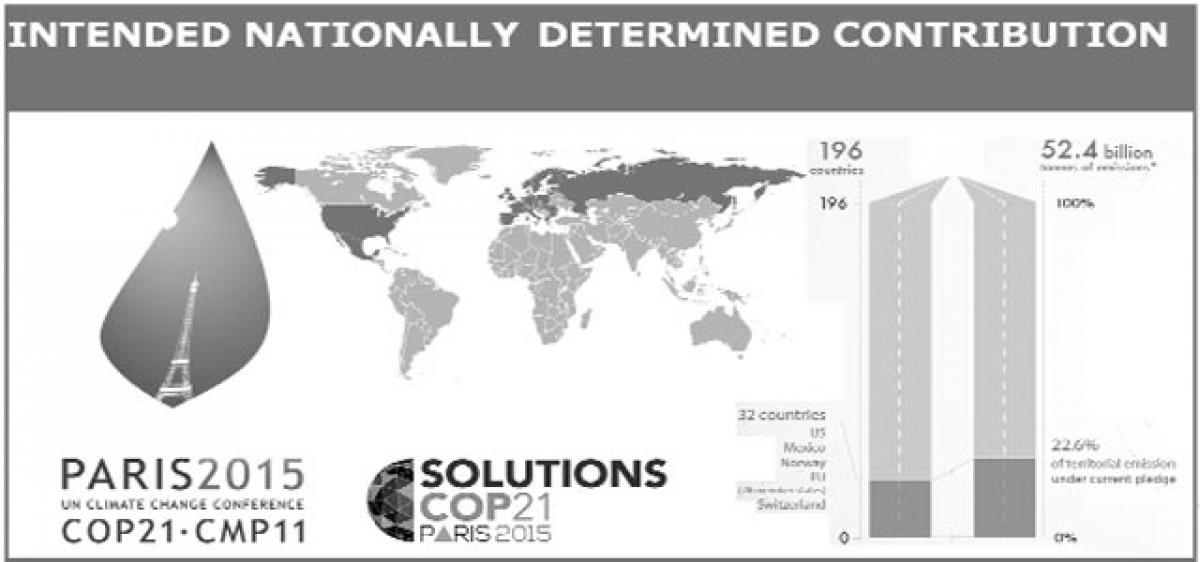Live
- BJP releases ‘charge sheet’ against BJD govt
- District Nodal Officer Venkataramana announced the intermediate results
- She team that stopped child marriages
- Medical devices sector needs separate rules, says industry body AiMeD
- Andhra Paper declares lockout
- Opposition INDIA bloc working on 'one year, one PM' formula: PM Modi
- Delhi HC quashes FIR for outraging woman's modesty, orders man to assist Traffic Police for a month as settlement
- 'Apologise to families of farmers who committed suicide in Vidarbha', Amit Shah dares Sharad Pawar
- SC Collegium recommends appointment of a permanent judge in Chhattisgarh HC, extension of term of two judges
- U20 Men's football nationals: Telangana, Sikkim earn full points with easy win
Just In

The term was intended as a compromise between \"quantified emissions limitation and reduction objective\" (QUELROs) and \"nationally appropriate mitigation actions\" (NAMAs) that the Kyoto Protocol used to describe the different legal obligations of developed and developing countries.
Intended Nationally Determined Contributions (INDCs) is a term used under the United Nations Framework Convention on Climate Change (UNFCCC) for reductions in greenhouse gas emissions that all countries that signed the UNFCCC were asked to publish in the lead up to the 2015 United Nations Climate Change Conference held in Paris, France in December 2015. These intended contributions were determined without prejudice to the legal nature of the contributions.
The term was intended as a compromise between "quantified emissions limitation and reduction objective" (QUELROs) and "nationally appropriate mitigation actions" (NAMAs) that the Kyoto Protocol used to describe the different legal obligations of developed and developing countries. Under the Paris Agreement, adopted in December 2015, the INDC will become the first Nationally Determined Contribution when a country ratifies the agreement, unless they decide to submit a new NDC at the same time.
Once the Paris Agreement is ratified, the NDC will become the first greenhouse gas targets under the UNFCCC that applied equally to both developed and developing countries. On August 3, 2016 China and US ratified 2015 agreement on INDC. Together they both constitute 38 percent of total global emission, with China's alone emitting total of 20 percent.
India that has a Global share of GHGs emission at 4.1 percent that of world ratified Paris climate agreement on October 02, 2016 by depositing the Instrument of ratification with the United nations The INDCs combine the top-down system of a United Nations climate agreement with bottom-up system-in elements through which countries put forward their agreements in the context of their own national circumstances, capabilities and priorities, within the ambition to reduce global greenhouse gas emissions enough to keep global temperature rise to two degrees Celsius.
The INDCs contain steps taken towards emission reductions and also aim to address steps taken to adapt to climate change impacts, and what support the country needs, or will provide, to address climate change. After the initial submission of INDCs in March 2015, an assessment phase followed to review the impact of the submitted INDCs before the 2015 United Nations Climate Change Conference Of surveyed countries, 85 percent reported that they feel challenged by the short timeframe available to develop the INDC.
Other challenges reported include difficulty to secure high-level political support, a lack of certainty and guidance on what should be included in INDCs, and limited expertise for the assessment of technical options. However, despite challenges, less than a quarter of countries said they had received international support to prepare their INDCs, and more than a quarter indicated they are still applying for international support. The INDC process and the challenges it is presenting are unique to each country and there is no ‘one-size-fits-all’ approach or methodology.

© 2024 Hyderabad Media House Limited/The Hans India. All rights reserved. Powered by hocalwire.com







